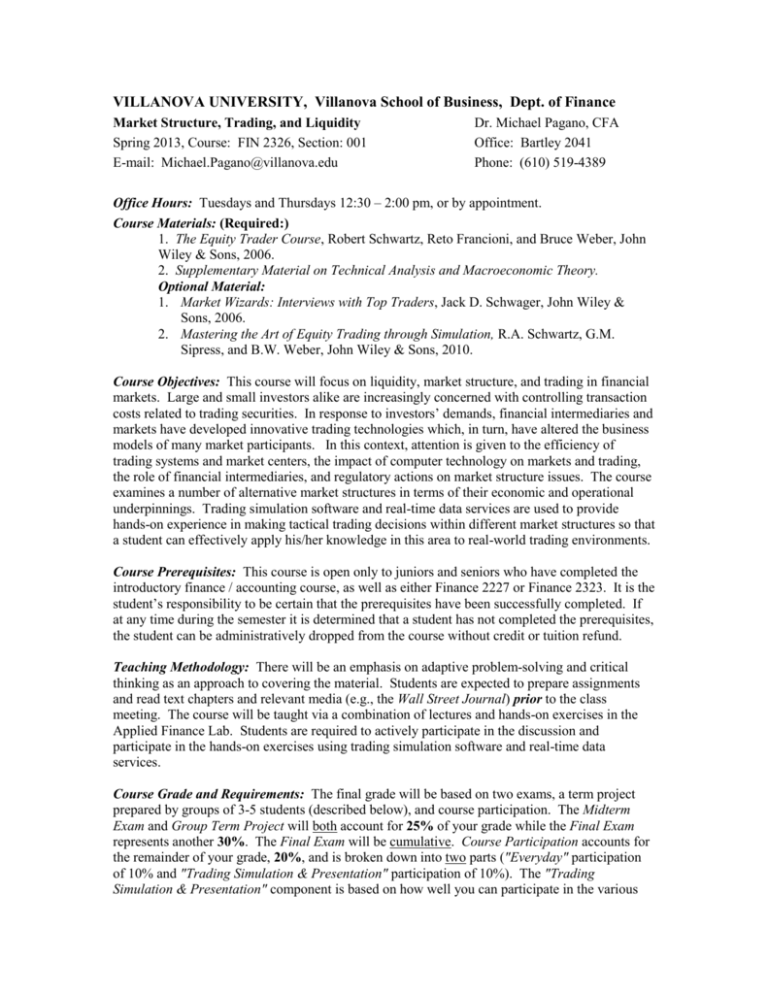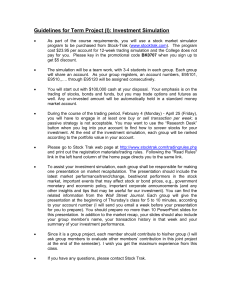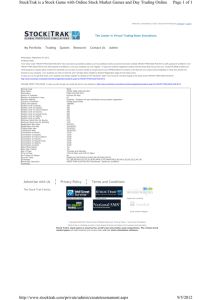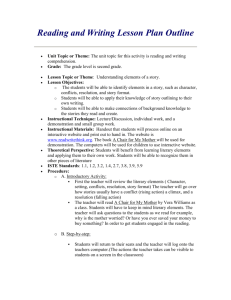Course Syllabus - Villanova University
advertisement

VILLANOVA UNIVERSITY, Villanova School of Business, Dept. of Finance Market Structure, Trading, and Liquidity Spring 2013, Course: FIN 2326, Section: 001 E-mail: Michael.Pagano@villanova.edu Dr. Michael Pagano, CFA Office: Bartley 2041 Phone: (610) 519-4389 Office Hours: Tuesdays and Thursdays 12:30 – 2:00 pm, or by appointment. Course Materials: (Required:) 1. The Equity Trader Course, Robert Schwartz, Reto Francioni, and Bruce Weber, John Wiley & Sons, 2006. 2. Supplementary Material on Technical Analysis and Macroeconomic Theory. Optional Material: 1. Market Wizards: Interviews with Top Traders, Jack D. Schwager, John Wiley & Sons, 2006. 2. Mastering the Art of Equity Trading through Simulation, R.A. Schwartz, G.M. Sipress, and B.W. Weber, John Wiley & Sons, 2010. Course Objectives: This course will focus on liquidity, market structure, and trading in financial markets. Large and small investors alike are increasingly concerned with controlling transaction costs related to trading securities. In response to investors’ demands, financial intermediaries and markets have developed innovative trading technologies which, in turn, have altered the business models of many market participants. In this context, attention is given to the efficiency of trading systems and market centers, the impact of computer technology on markets and trading, the role of financial intermediaries, and regulatory actions on market structure issues. The course examines a number of alternative market structures in terms of their economic and operational underpinnings. Trading simulation software and real-time data services are used to provide hands-on experience in making tactical trading decisions within different market structures so that a student can effectively apply his/her knowledge in this area to real-world trading environments. Course Prerequisites: This course is open only to juniors and seniors who have completed the introductory finance / accounting course, as well as either Finance 2227 or Finance 2323. It is the student’s responsibility to be certain that the prerequisites have been successfully completed. If at any time during the semester it is determined that a student has not completed the prerequisites, the student can be administratively dropped from the course without credit or tuition refund. Teaching Methodology: There will be an emphasis on adaptive problem-solving and critical thinking as an approach to covering the material. Students are expected to prepare assignments and read text chapters and relevant media (e.g., the Wall Street Journal) prior to the class meeting. The course will be taught via a combination of lectures and hands-on exercises in the Applied Finance Lab. Students are required to actively participate in the discussion and participate in the hands-on exercises using trading simulation software and real-time data services. Course Grade and Requirements: The final grade will be based on two exams, a term project prepared by groups of 3-5 students (described below), and course participation. The Midterm Exam and Group Term Project will both account for 25% of your grade while the Final Exam represents another 30%. The Final Exam will be cumulative. Course Participation accounts for the remainder of your grade, 20%, and is broken down into two parts ("Everyday" participation of 10% and "Trading Simulation & Presentation" participation of 10%). The "Trading Simulation & Presentation" component is based on how well you can participate in the various tasks related to trading exercises based on our simulation software, a related 10-minute class presentation of your simulated trading experience, and a 3-page (double-spaced) write-up. It is your responsibility to inquire about any assignments, readings, handouts, etc. if you miss class for any reason. Please be prepared for class by reading the assigned chapter before the day that the chapter is scheduled to be discussed. Also, it is recommended that you keep up with current business and financial events by reading publications such as The Wall Street Journal, The Economist, and Barron’s. Please see rules for the exams below. Computer Simulation: Simulation software (TraderEx) will be used in the course for in-class demonstrations and homework assignments. When using the simulation, you will enter orders and/or quotes into a computer-driven market that generates order flow and that responds directly to your orders. You will see your results in real-time and analyze them after play. Auction, dealer, and hybrid markets can be simulated. The simulation should deepen your awareness of what trading involves and sharpen your trading skills. You will be responsible for preparing a group-based project which entails a 10-minute presentation of your simulated trading experiences, as well as a 3-page write-up (double-spaced). Exam Rules: 1. You can bring one card or one sheet of formulas no larger than 8 ½’’ x 11”. 2. Except for a documented medical emergency, a missed exam will be graded as a zero (0 points). Students with documented medical emergencies will get a make-up exam that is different from the one given in class. 3. Academic dishonesty will not be tolerated. 4. These rules complement the normal rules of the College/University. Academic Integrity Policy: The Code of Academic Integrity of Villanova University addresses cheating, fabrication of submitted work, plagiarism, handing in work completed for another course without the instructor’s approval, and other forms of dishonesty, such as discussing the content of an exam with a student who has not taken that exam. For the first offense, a student who violates the Code will receive 0 points for the assignment. The violation will be reported by the instructor to the Dean’s Office and recorded in the student’s file. In addition, the student will be expected to complete an education program. For the second offense, the student will be dismissed from the University and the reason noted on the student’s official transcript. Students with Disabilities: It is the policy of Villanova to make reasonable academic accommodations for qualified individuals with disabilities. If you are a person with a disability please contact me after class or during office hours and make arrangements to register with the Learning Support Office by contacting 610-519-5636 as soon as possible. Registration is needed in order to receive accommodations. Home Page: You can also see my web site for some useful information and updates: (www.homepage.villanova.edu/michael.pagano) Course Outline: A. Introduction to the Fundamentals This section of the course is devoted to understanding the key components that make up a financial market (information, prices, transaction costs, liquidity, as well as the types of trades and investors). In addition, we will examine ways to measure the informational efficiency and quality of a market. Class/Date Topic Chapter Jan 15, 17 Introduction and Overview: Why are Financial Markets and Intermediaries Special? 1 Jan 22, 24 Introduction to Applied Finance Lab Resources Lab Resources 1 On-line Trading Begins and Stock Choices Due Jan 31 Jan 29, 31, Feb 5 Getting a Grip on Trading: Liquidity, the Bid-Ask Spread, and Trading Simulations Feb 7, 12, 14 All About Liquidity: Trading Dynamics, Liquidity Provision and Price / Quantity Discovery 2, Appendix (pp. 363-371) Feb 19, 21, 26 Using Limit and Market Orders: Patience vs. Immediacy, Limit Order Costs, and Order Handling Feb 28 MIDTERM EXAM (in alternate classroom) 3, including Exercises as midcourse assignment 1-3, Appendix Mar 4 – Mar 10 Spring Break Mar 12, 14 Mid-term Exam Review and First Half Wrap-up B. Alternative Market Structures and Trading This section examines in more depth the various fundamental types of financial markets (order vs. intermediated) as well as the roles of institutional order flow, technology, and regulation in determining effective market structures and informed trading strategies. We will also study the impact of the macroeconomy on financial markets. Mar 19 Trading Simulation Presentation & Write-up Mar 21 Making the Trade: Risk, Return, and Execution Management Navarro Ch. 15-17 Hand-out Mar 26, Apr 2 Key Macroeconomic Theories of the Business Cycle and their Impact on Financial Markets Abel & Bernanke Ch. 8, 10-11 Hand-out Mar 28–Apr 1 Easter Recess (No Class on Mar 28) Apr 4, 9 Apr 11, 16 Market Intermediaries: Intermediation at the NYSE vs. Nasdaq, Market Maker Operations, and Hybrid Markets 5 Apr 18, 23 Algorithmic Trading and Technical Analysis: the Challenges of Price and Quantity Discovery 6 Apr 25 Performance Measurement: Transaction Cost Analysis, Risk Management, Best Execution, Regulatory Issues 7 April 30 May 2 No Class due to Friday Schedule May 6 FINAL EXAM (2:30 – 5:00) Review Note: This is a preliminary outline that is subject to change. Ch. 3 Exercises Due Term Project Due Cumulative Group-based Term Project: Overview: This group-based project is designed to give you an opportunity to apply some of the tools and principles learned in this course to real-world financial data and situations. The project involves gathering and analyzing information about a specific company and one of its main competitors from either the NYSE or Nasdaq National Market System with a market capitalization of $500 million or more (three possible choices should be submitted to me by January 31). The project entails writing a 10-page (maximum!) research paper on the estimated market quality of trading in your specific stock as well as participation in a Trading Game as described in the Hand-out titled “Ch. 5 The Trading Game.” Your research paper should discuss both the results of the market quality estimation for your chosen stocks and the performance of your trading decisions based on the Trading Game rules. Market Quality Estimation Procedures: To estimate the market quality of trading in your chosen stock (and its main competitor), you will use conventional measures such as the monthly average and median bid-ask spreads, daily trading volume, average market capitalization, and return volatility using data for the past 5 calendar years (Jan. 1, 2008– Dec. 31, 2012). In addition, you will estimate both stocks’ bid-ask spread “smiles” for hourly intervals during each trading day during one calendar year: Jan. 1, 2012 – Dec. 31, 2012. You can obtain these bid and ask data from the NYSE TAQ database (available via WRDS) for the following time intervals for each trading day during the one calendar year: 9:30, 10:30, 11:30, 12:30, 1:30, 2:30, 3:30, and 4:00 pm. You can then use regression analysis and the following model to infer each stock’s intraday liquidity. The following model simply regresses the bid-ask spread at each time interval for all trading days during the relevant calendar year: spread t t 2 h ,t 0 1 h ,t 2 h ,t (1) h ,t where, spreadh,t = the bid-ask quoted spread at the h-th hourly interval on day-t (askh,t – bidh,t), th,t = a time index representing the h-th hourly interval for each day (i.e., th,t = 1 for the 9:30 am interval for every day, th,t = 2 for the 10:30 am interval, and so on until th,t = 8 for the 4:00 pm interval), t2h,t = the nonlinear, quadratic form of the time index obtained by squaring the time index (i.e., 12, 22, and so on up to 82), = intercept term, = a measure of the stock’s sensitivity to the linear time index, = a measure of the stock’s sensitivity to the nonlinear, quadratic form of the time index, and h,t = random error term (model residual) with zero mean. To test the market quality of trading for your chosen stocks, you will need to run the above regression of Equation (1) for all trading days during the relevant calendar year and for both of your two stocks. You can then use the results of your two regressions (one for each stock) to test the statistical significance of each regression’s parameter estimates ( , , and ). The expectation for Equation (1) if market frictions are present is that the model’s parameter, , is significantly negative and the parameter, , is significantly positive. If the market quality of trading in the stock is poor, then we expect both parameters to be statistically significant. If there are no trading frictions and market quality is very good, then we expect both of these parameters to be insignificantly different from zero. You can test this hypothesis regarding the parameters via a conventional two-sided t-test. You can also compare the parameter estimates of your two stocks to determine which one has better market quality via a joint t-test. Trading Game Results: Throughout the semester, starting on January 31, you will make trading decisions using an on-line order management system to invest $100,000 in up to six U.S. stocks (each with a minimum market capitalization of $500 million). You should follow the rules of the trading game as described in the Hand-out titled “Ch. 5 The Trading Game,” and incorporate the results of your trades (and decision-making process) within the 10-page research paper. Report Format and Guidelines: You must submit a (maximum!) ten-page report (double-spaced and excluding tables/graphs) that covers all of the main areas described in this section. Financial and statistical analysis for your specific company (and its main competitor), as well as other relevant principles covered in class, should be applied in order to develop a coherent, concise, properly referenced (and grammatically correct) report. Also, you should discuss the relevant market-wide factors in the macroeconomy and how they may have affected your results. For example, you can explain your results in light of the stage of the U.S. business cycle, industry-specific factors, and financial market changes. Graphs and tables may be incorporated. All sources employed in your analysis must be included in a bibliography and footnotes should be used to cite specific information from those sources. A computer-generated spreadsheet supporting your financial analysis should also be included, along with other relevant supporting materials, in an appendix. DO NOT INCLUDE ANY COMPUTER OUTPUT DIRECTLY FROM A STATISTICAL ANALYSIS PACKAGE. Plagiarism will clearly not be tolerated. Data Sources: Several on-line and hard-copy sources of information can be of use to you in preparing your report. A list of some relevant sources includes (but is not limited to) the following: WRDS’ access to the Center for Research in Security Prices (CRSP) Stock Return database, Global Insight online U.S. macroeconomic database, NYSE TAQ (Trade and Quote) database, and real-time data services such as FactSet and the Bloomberg Terminal (all available at the Applied Finance Lab in Bartley, Room 25), as well as via targeted searches on ABI-Inform, Factiva, etc. Report Guidelines: Your 10-page (maximum!) report should follow the outline presented below: I. Executive Summary: This section should provide a brief (e.g., in 1-2 paragraphs) description of the company you have chosen to analyze and your overall assessment of the market quality of trading in this company’s stock (and its main competitor) during the past five calendar years. In addition, you can briefly summarize here the results of your Trading Game decisions. II. Conventional Measures of Market Quality and Liquidity: This section should provide summary statistics (mean, median, s.d., min, max, etc.) for key market quality measures such as the bid-ask spread, average stock price, average monthly market capitalization, average 1and 2-day returns, standard deviations of 1- and 2-day returns, 1- vs. 2-day return variance ratios, and daily trading volume. You should then analyze and discuss these results for both stocks in a concise, cogent manner. III. Regression-based Measures of Market Quality: This section should report the results of the above two regression analyses (i.e., the regressions based on Equation 1 for your two stocks). As in the previous section, you should also analyze and discuss these results in a concise, cogent manner. IV. Macroeconomic and Market Conditions: This section should analyze the macroeconomic and financial market conditions that affected your stocks during the sample period. As noted earlier, you can explain your results in light of the specific stage(s) of the U.S. business cycle, industry-specific factors, and financial market changes (e.g., recessionary vs. expansionary economic conditions and/or bull vs. bear market conditions). V. Trading Game Results: This section should discuss the results of your trades (and decisionmaking process) related to the Trading Game. Report each trade you made and the profitability of each trade (and overall profitability of the portfolio) on a risk-adjusted basis in a spreadsheet format. Describe your thought process in terms of entering and liquidating each position, as well as any risk management techniques you employed. VI. Conclusion: This section should briefly (i.e., in 1-3 paragraphs) summarize the main points described in the previous sections and provide an overall conclusion based on your empirical and trading results. Project Due Date: Your report is due at the beginning of the last class date (i.e., May 2). LATE SUBMISSIONS WILL NOT BE ACCEPTED.







